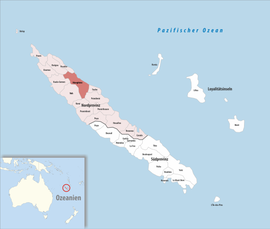Hienghène | |
|---|---|
 "La Poule" (the hen) cliff in Hienghène | |
 Location of the commune (in red) within New Caledonia | |
| Coordinates: 20°41′39″S 164°55′20″E / 20.6941°S 164.9222°E | |
| Country | France |
| Sui generis collectivity | New Caledonia |
| Province | North Province |
| Government | |
| • Mayor (2020–2026) | Bernard Ouillatte[1] |
| Area 1 | 1,068.8 km2 (412.7 sq mi) |
| Population (2019 census)[2] | 2,454 |
| • Density | 2.3/km2 (5.9/sq mi) |
| Ethnic distribution | |
| • 2019 census | Kanaks 94.17% Europeans 2.36% Wallisians and Futunans 0.12% Mixed 2.61% Other 0.73% |
| Time zone | UTC+11:00 |
| INSEE/Postal code | 98807 /98815 |
| Elevation | 0–1,628 m (0–5,341 ft) (avg. 20 m or 66 ft) |
| 1 New Caledonia Land Register (DITTT) data, which exclude lakes and ponds larger than 1 km² (0.386 sq mi or 247 acres) as well as the estuaries of rivers. | |
Hienghène ([jəŋ.ɡɛːn];[3][4] Fwâi: Hyehen) is a commune in the North Province of New Caledonia, an overseas territory of France in the Pacific Ocean. It is located on a bay called Hienghène Bay, known for its eroded limestone islets.[5]
The islets are remnants of a limestone and silica formation that once covered the whole of the bay, some 40 million years ago.[5] Erosion from wind and water carved away the softer limestone, leaving the harder silica behind in eye-catching formations. Several of these formations have been given fanciful names, such as the Sphinx, the Towers of Notre Dame, and the Hen (pictured).[5]
YouTube Encyclopedic
-
1/3Views:3 6982 8721 687
-
Nouvelle-Calédonie 2012 : HIENGHENE.
-
hienghène coutume 29 11 2014
-
Hienghène le 29 11 2014 (vidéo)
Transcription
References
- ^ "Répertoire national des élus: les maires" (in French). data.gouv.fr, Plateforme ouverte des données publiques françaises. 13 September 2022.
- ^ Population, ménages et logement par commune, en 2019, Institut de la statistique et des études économiques Nouvelle-Calédonie
- ^ Wallis, Mary Davis (25 June 1994). The Fiji and New Caledonia Journals of Mary Wallis, 1851-1853. [email protected]. ISBN 9789820200951 – via Google Books.
- ^ Stanley, David (3 December 2004). Moon Handbooks South Pacific. David Stanley. p. 858. ISBN 9781566914116 – via Internet Archive.
Hienghène pronunciation.
- ^ a b c Scheffel, Richard L.; Wernet, Susan J., eds. (1980). Natural Wonders of the World. United States of America: Reader's Digest Association, Inc. p. 179. ISBN 0-89577-087-3.

